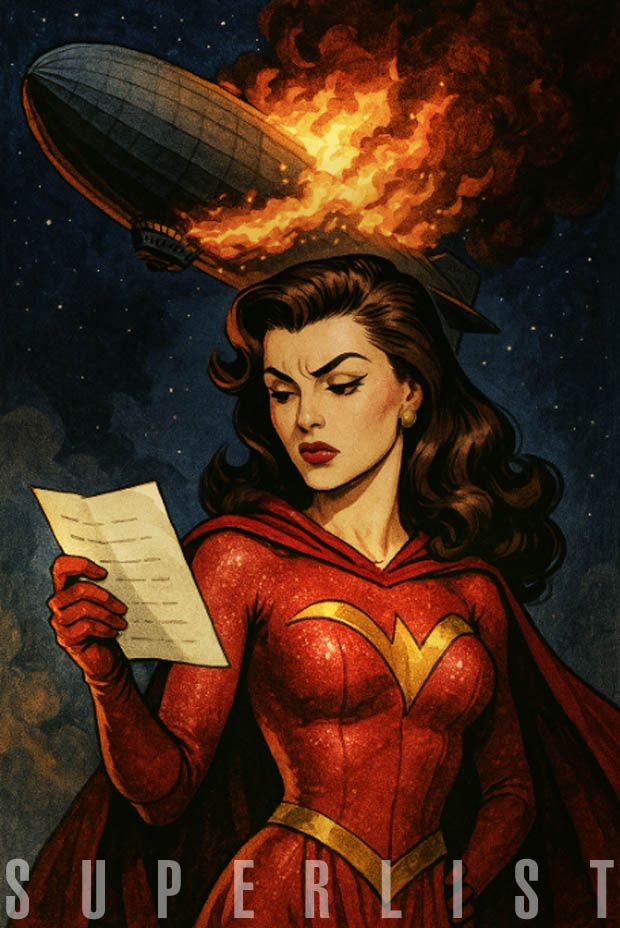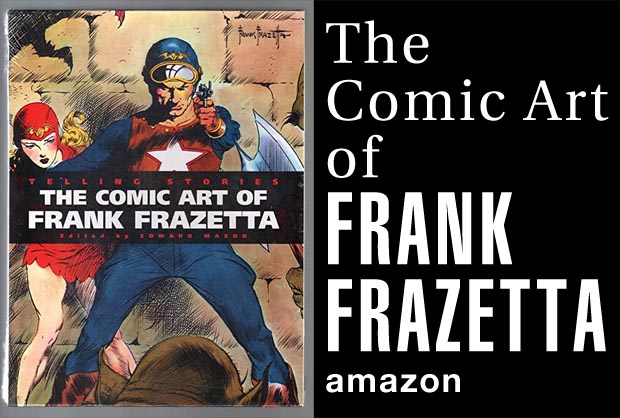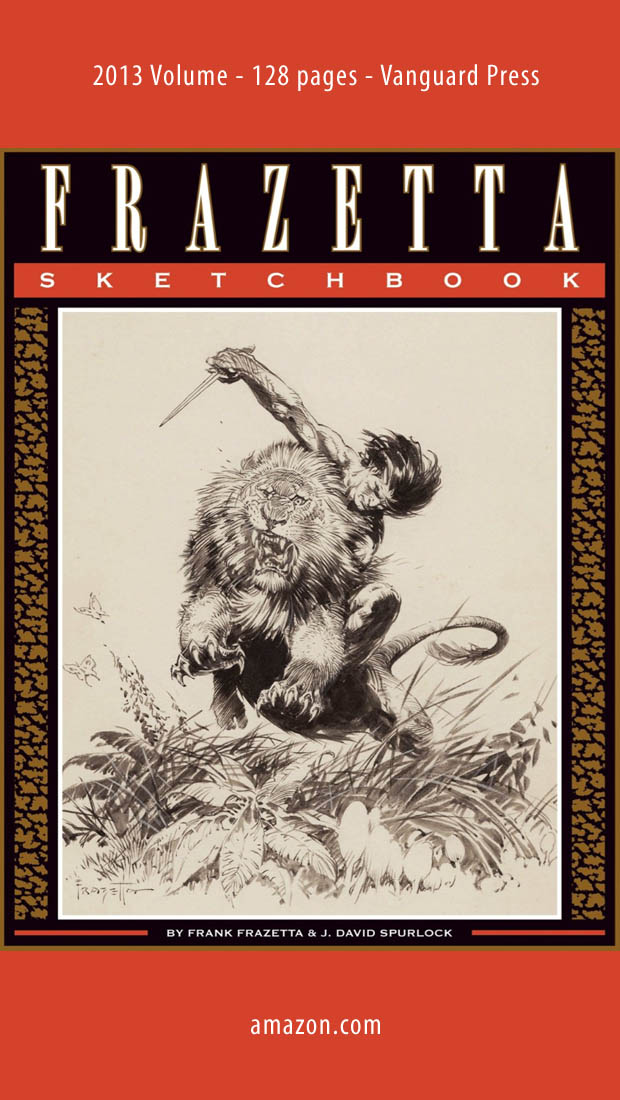Frank Frazetta - 1928 - 2010
A Frank Frazetta Appreciation
This essay was rewritten just after Frazetta's death in 2010
This had been a tough past year for Frazetta Sr: his wife and de facto business manager Ellie Frazetta died of cancer in July 2009, and then in December their son Frazetta Jr. staged a raid on the 'Frazetta Museum' with the (apparently) dubious task of kidnapping the bulk of the Frazetta Museum artwork (Frazetta Jr., originally stated he was acting on order from Frazetta Sr.) to put it into storage and to keep it out of the hands of the three other siblings.
Besides the criminal legal problems from this event, there was much news made of the fallout from claims and counter-claims being made within the family about a $1 million dollar sale of "Conan the Conqueror" to Metallica guitarist Kirk Hammett.
In April Frazetta came out of a kind of exile at his home on Boca Grande island in Florida. The apparent intention was to settle the family feud and to straighten out the tangle of legal deals surrounding the copyrights for Frazetta Properties. This was followed as an ongoing news item by fans and internet news outlets each step of the way.
I am sure I was not the only one expecting a death announcement for Frank Sr., since the death of Ellie Frazetta in 2009. With Frazetta having dodged a number of life-threatening health problems over the last two decades (severe thyroid problems, strokes), he probably had already outlived most expectations. Nonetheless, he kept drawing (left handed after losing control over his right hand from a stroke) and he kept going by touching up older paintings (which is something that many artists in their elder years do, not always to good effect). And there were periodically announcements made at the web site run by Frank Jr. for new merchandising deals based on his artwork.
Though Frazetta the company had become an "intellectual property" marketeer with T-shirts, clocks, posters and everything else one can sell with an image plastered to it, Frazetta the artist was a much-loved author of images that spanned from comics to books to album covers to movie posters, and beyond. He was revered by many other artists for a technical ability and a compositional style that, whether you liked his art or not, influenced just about everything that followed in the wake of his fame as an artist. I have seen innumerable images on movie screens that were obviously related to specific paintings by Frazetta, or in style that is only a generation apart from his artwork themes and style. The number of ways Frazetta has impacted comic books and fantasy illustration is not easily calculated, and the way his impact on Hollywood is measured through imitation is another place only a specialist could determine.
Frazetta called "the Michelangelo of Fantasy Art"
Obviously similar to Michelangelo by possessing the same kind of anatomical obsessions, and for focusing his images into a kind of 'theology of the body' which Michelangelo held to, there are nonetheless telling differences. Michelangelo Buonarroti was a trained anatomist who engaged in dissection on corpses under the supervision of medical personnel in order to learn as much as possible about the true functioning and shapes of muscles. In contrast, Frazetta trained himself using George Bridgman's famous guide "Anatomy for Artists" and he also employed an apparent photographic memory that was combined with using photographic reference, life drawing and his own imagination.

Whereas Michelangelo challenged his contemporary critics to find error in his anatomy (he was accused of making up "extra" muscles in the bulging and twisting bodies he used in sculpture and painting), Frazetta, on the other hand, readily admitted that he distorted and caricatured his figures to bring them into line with what he wanted to present, for example telling a Washington Star reporter in 1977 that "he knew what the fans expected."
Frazetta and photography
Though Frazetta claimed to not use reference photographs and to instead rely upon memory and his own talent for invention, this is of course not true for some of his most commercial work. For example the caricatured portrait of Ringo Starr from Mad Magazine, the image which gained Frazetta the attention that led to his movie poster career, is clearly modeled from photos of the famous Beatle.
Pop culture images were in Frazetta's head and came out in many ways, for example references to DeMille's "Cleopatra" and other films, from King Kong to westerns and so forth. In the past, llustrators like N. C. Wyeth traveled into the American West to gather first-hand visual information used for later paintings of cowboys and Native Americans, Frazetta's renditions of the same items are based upon movies, television and book illustrations he had seen.
But it is in this plethora of derivitive pop culture imagery where Frazetta's distinction comes out in force: his personal understanding of the athletic shape and performance of a human body under stress. Getting the peripheral costuming correct is much less important in Frazetta's world, whereas it would be paramount in a trained illustrator like Wyeth, Pyle or Remington. Frazetta's focus transcended likeness, blandishments of even a specific culture, but went towards the universality of the human form, and this is what ultimately couples him with an artist like Michelangelo (or Bernini or Rodin).
As an avid collector of cameras Frazetta certainly had the means and ability to use photos as tools. In Frazetta literature there are many black and white images which showed studies in contrast and lighting of either Frazetta himself or a colleague that appear to be instrumental in the black and white artwork he was producing in comic books in the 1950s. Frazetta educated himself in many ways and seems to have known how to assemble a seed-bed of visuals to pull from for his own imaginative purposes.
But no reference image could exist for the way Frazetta depicted the fluid motion and the thrust of action he could bring out in his images. Artists use any number of "crutches" to get over not knowing how something looks in a certain situation, but only an imagination combined with a familiarity with athletic, physical action can account for figure motion like Frazetta could draw and paint.
Frazetta's style
Frazetta had the subtlety to dilute the brutality of many of his scenes with other emotions on the canvas. His barbarian fighters often show a sense of panic or dread, something repeated in both the victor and the defeated, which is a shading quite apart from the pure anger or expression of triumph in a typical 'barbarian' image.
Frazetta wasn't adverse to adding in editorial to his images, either, such as the death figure leering at the leaping Conan in "The Conqueror" (aka "Berzerker").

Frazetta seems to have had a simple commercial goal of "knocking their eyes out" with his imagination and an embellishing style that only got better as Frazetta aged, even though his drawing talent eventually declined. His early imagery for the Tarzan, John Carter and Conan books were meant to capture what Frazetta called 'the peak moment,' which typically meant a figure in action. By the 1980s, though, most of his images were replaced with posing postures, as if the figure has already accomplished the goal and is now living in a moment of earned accolades. This arc of change seems to match Frazetta's own status as an artist over the decades, as one of his key comments in interviews was his realization at a certain point in his career that he was able to support his family with his work, something which begs the question of how long was the fear of failure and the grind of freelance labor being integrated into his images?
Death Dealer
An example of this transition is his possibly most famous work, "Death Dealer" which is a beautifully rendered, menacing artwork of a classic death image. But, it is an image that only implies all the mayhem and aggression actually contained in Frazetta's earlier work.
In his later years Frazetta tinkered regularly with older images, sometimes improving, and sometimes not. At other times, he was simply finishing a painting, Frazetta being famous for 24 and 48 hour orgies of focused labor, which did not always mean the most 'finished' of color images during his long stretch of illustration work during the 1960s.
As Frazetta aged into his 60s and 70s, he only produced a handful of new images, instead he either copied his own work in variations (like Death Dealer running, Death Dealer in a swamp, etc) or he helped package older images for new merchandising applications.
Usually this tinkering with old artwork made for a much better embellishing effect, but not always a better composition. Sometimes it simply degraded the image as a piece of artwork. For example, he might rework an old paperback cover, changing the focus from being the fright of a woman facing a ferocious animal in the wild, to instead a transformation of the piece into "cheesecake" with all the focus on a dramatically rendered derriere. By so completely changing the "point" of the artwork, Frazetta was canceling one artwork, and introducing another, and in the worst cases, he simply trasnformed a unique piece into just another version of something he had already done dozens of times elsewhere.
As Frazetta reworked older images in this pointless manner, the question comes up: was he simply bored? It is a thread in art history that many artists who lived long enough to go back and "fix" older images often get lost without a sense of what their younger self intended, damaging paintings in the process.
A Defense of Frazetta
If this sounds like simple criticism, remember the aged, elder Frazetta was still drawing and painting but only with his left hand, the right hand destroyed (for useful art purposes) by a stroke. Like the wealthy and accomplished Renoir in his private garden, who had to have his brushes bandaged to his arthritic hands because he couldn't hold them, Frazetta kept working even though he was long past the stage where he was needing to earn a living and feed a family.
When I see Frazetta paintings, especially the images he made in his prime working years after he was blackballed by Al Capp (after Frazetta spent years 'ghosting' the popular comic strip tale of hillbillies in Dogpatch, Arkansas, work which the older Frazetta said was 'time wasted'), I don't just see a stock phantasy image that illustrates a (often) second rate adventure-quasi-sci-fi tale. Instead I see the aggressive, often angry and fear-filled expression of an independent artist and illustrator fighting to make a living while dealing with art directors and the terror of the sink-or-swim reality of the commercial art market.
In fact, I think the viewer with an eye for the details of Frazetta's work will note the startling constancy that Frazetta's heroic figures typically resemble Frazetta himself (look at the eyes and cheek bones), and the women typically all resemble variations on his wife Ellie. Like American writer Edgar Allen Poe who seems to have only been writing about himself in his tales, regardless of the actual character in a story, Frank Frazetta seems to have been regularly simply drawing and painting self-portraits and things that were much closer to him than a distant fantasy world.
- Huntley Haverstock
More Frank Frazetta
Fantastic Paintings of Frazetta Hardcover – July 21, 2020
by J David Spurlock (Author), Frank Frazetta Jr. (Afterword)
Fantastic Paintings of Frazetta - AMAZON
Telling Stories: The Comic Art Of Frank Frazetta-Hardback - AMAZON
Frazetta: The Definitive Reference - Amazon
Frazetta Sketchbook (vol II) (Vanguard Frazetta Classics) - Amazon
Conan the Phenomenon - Dark Horse Conan historian Paul Sammon looks at all the stages of the character's development, with commentary and archival material from the most integral players in that history, in this must-have book for anyone who's followed the barbarian through any of his incarnations.
Frazetta - Painting with Fire by Eleanor Frazetta - documentary - AMAZON
Frank Frazetta - Fire and Ice (Two-Disc Limited Edition) - AMAZON
Harcover Collection: Legacy by Frank Frazetta - AMAZON
Original Page 2009 | Updated July 2013 | May 2021


